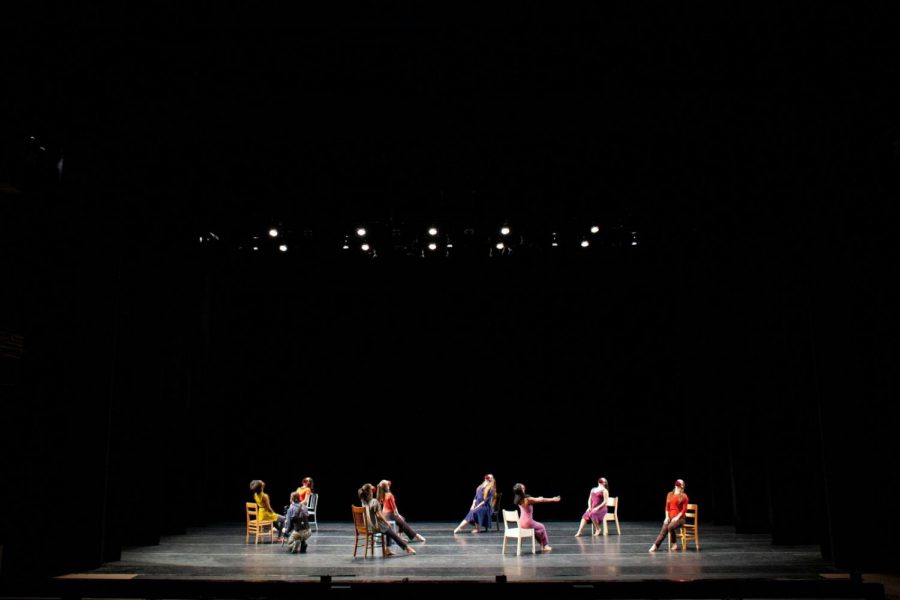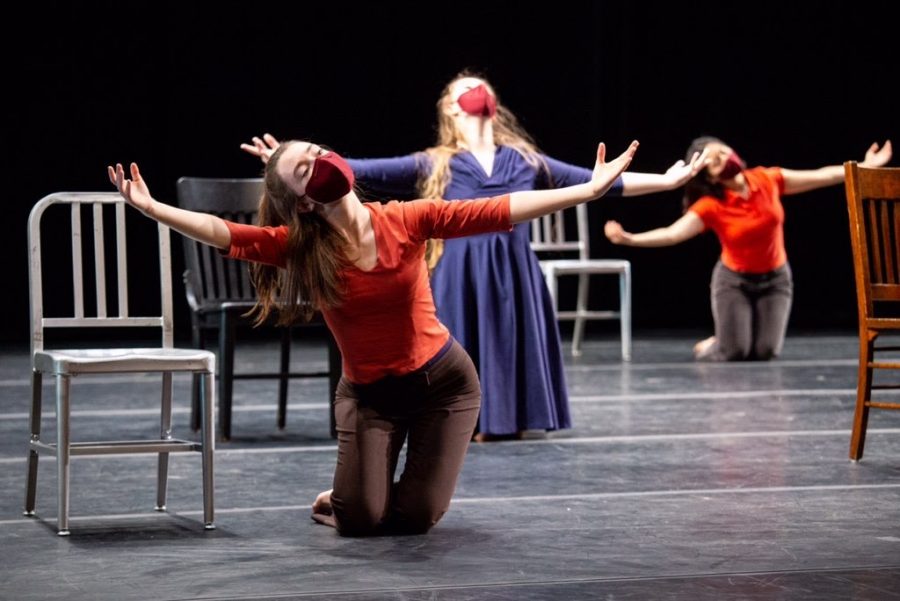CoDa addresses isolation in Zoom adaptation of Sokolow’s ‘Rooms’
April 21, 2021

For the dancers of CoDa, the contemporary dance ensemble at Williams, they learned, practiced, and performed all on Zoom. The dancers were separated by masks, distance, and often miles as they prepared for their April 10 Zoom webinar in which they exhibited a suite of dances from Anna Sokolow’s Rooms. The dancers’ physical separation was both necessary and symbolic, as the piece focused on the isolation created by the global pandemic moment.
Rooms (1955) was created as a response to the isolation and unfulfilled desires experienced by those living in New York City apartments in the 1950s. But today, as the world experiences a new form of separation during the COVID-19 pandemic, the piece has developed new meaning and value.
The suite, performed by 11 on-campus and two off-campus students, was captured and assembled into a film by Assistant Professor of Art Sarah Rara. The suite was composed of three thematic dances titled “Alone,” “Desire,” and “Daydream.” The dancers were all spaced six feet apart on chairs, and the remote students’ videos were projected onto the stage alongside the other dancers.
The work was a collaboration with the Sokolow Theatre Dance Ensemble, and the choreography was taught on Zoom by director Samantha Géracht. The group began practicing in September for its November filming date, meeting multiple times a week. “In one of the rehearsals we had, we spent the entire time practicing sitting and standing up, and I think that really spoke to the entire experience,” said Dover Sikes ’24, who is one of CoDa’s dancers. “It was all about doing little things with intention and building off that.”
The movement aimed to portray the emotive enormity of isolation via modern dance. “This was the ideal way to have young people be able to express what this experience has been like for them,” Co-Artistic Director of CoDa Erika Dankmeyer said. “It felt very contemporary and very of the moment.” The iconic piece has been translated across many institutions as the pandemic has evolved, as it is easily practiced and performed in distanced formats.
“These works exist for a reason,” Co-Artistic Director of CoDa Janine Parker said. “Rooms is relevant, pandemic or no — most of us have experienced the feeling of isolation in our lives, even when we are surrounded by people.”
The piece took on a larger meaning for the dancers and directors as the production progressed. “We all ask ourselves the questions: Am I seen?” Parker said. “Am I important? Am I making an impact? Do I matter to my friends? Am I a good student? All of these anxieties are present in Rooms, even without the pandemic, the isolator of all isolators.” The work became a way for the dancers to express and support themselves during a tumultuous time, according to Parker.
Each thematic piece fit into the larger depiction of the emotional turmoil of the pandemic. The first thematic dance “Alone” was poignantly still as the dancers began by sitting in their chairs, each separated in their own realm of solitude and despair. In “Desire,” the second dance, the dancers aimed to “feel true desire for something so our movements had real intention,” as Sikes put it, and their motion intensified as they reached out into the empty air surrounding them.
Lastly, the dancers performed “Daydream,” which emphasized lateral and upwards movements. “We focused on movements that would pull you up or to the side, but then you would look away, getting dragged back down into reality,” Sikes said. The dancers transitioned from emotion to emotion through changes in motion and gesture.
“This is what modern dance often does — the movement itself [acts] as a manifestation of the emotion,” Dankmeyer said. “It’s not that you have to add that layer on top. It’s that if you really work to understand how to approach the movement, the emotion is the same.”
“It was definitely different from anything I have ever done,” Sikes said.

Dankmeyer said she was inspired by the global experience of the pandemic to create a piece that embodied the experience of COVID for the College community. “I wanted the piece to be Williams-centric and to consider what is happening at Williams College in this historic moment,” she said. “When you look at how Williams has managed COVID, it has not been perfect, but the level of detail, consideration and support that Williams has been able to provide has been remarkable.”
In order to make the production as true to Williams as possible, Dankmeyer reached out to other departments at the College. “I reached out to two faculty members that I had never met, Kris Allen in the music department and Sarah Rara in the art department for the film,” Dankmeyer said. “There were a lot of really wonderful things that just fell into place.”
Allen assembled a group of students from his jazz ensemble to record the Kenyon Hopkins score for the dancers. The original score was a rough recording from a basement in New York City in the 1950s. “If you listen hard, you can hear the sound of traffic and sirens going by,” Sikes said.
“That recording itself brought you into that historic moment,” Dankmeyer added.
As a smaller community, the members of the CoDa dance group grew very close to one another, even as they practiced and performed six feet apart. “The sense of community with dancers is very important,” Parker said. “We become small families. I am glad to say that the dancers embraced that, even if we could not embrace each other.”
So while Rooms was not the typical dance experience, the performers were still able to make connections — and art — from a distance. “This was one of the bright lights in a pretty dismal fall. It has given me a lot of joy and faith,” Dankmeyer said.“This has reminded me of why I love dance and what is possible because of dance.”







